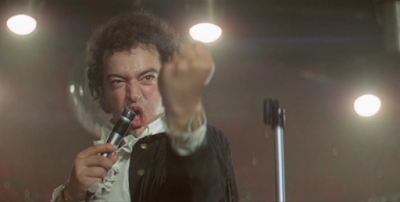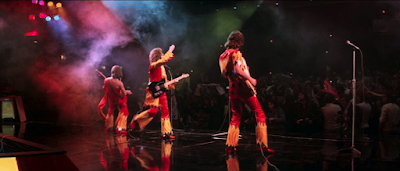The early seventies… they say if you can remember them you weren’t really there… oh, hang on, that’s the sixties. I may have been only ten but I was definitely there for the explosion of grimy glam rock that blew our junior-school minds after years of well-behaved formulaic bubble gum from The Osmonds, Dawn, The New Seekers and even my once beloved Middle of the Road. Glam was a turn in the road, a call to revolt and it touched our unruly instincts as we felt a connection to the sheer naughtiness and noise of Slade, Sweet and T-Rex starting in 1971 and for the next three years and beyond. We no longer cared where our mother had gone, we just wanted to get down and get with it… even if it was only in the Friday lunchtime school disco!
Slade were the greatest exponents of Glam but with a gritty
edge that under-lined all of the best acts: these guys may have worn make up
and glitter but they were in the main hard as nails: call Steve Priest an artiste and
he’d probably give you a bunch of fives in the parlance of the time. Slade were, at one point, a “skinhead
act” and, much like Oasis in the 90’s, they were working class lads who just
loved The Beatles. Unlike the Gallaghers though, they brought their own songs
filled with original melodies as well as fierce riffs.
They may not have known it but Slade had peaked by the time they filmed Slade in Flame and were in search of the new challenge it bought, or at least their manager Chas Chandler (ex-Animal and Jimi Hendrix’s manager) was. Several daft ideas were mooted – The Quite-a-mess Experiment being quickly dismissed not least because Dave Hill would have been despatched in scene two… In the end the band followed the Hard Day’s Night route but, rather than just mimic the actuality of the band’s existence the team devised a harder-edged drama that was loosely- based on their career and, crucially, their characters but one that was also drawn to the cynical end of the pop machine. This wasn’t Slade’s biography but it was an amalgam – amal-glam! – of theirs and many other bands experience in the dingy, cut throat, beer-stained, bingo halls and working-mens’ clubs of provincial Britain.
 |
| Noddy Holder in the Seventies |
Released in 1974 - it is pure 1974 - the last time Slade
would produce material of the quality of Far, Far Away and the sublime How Does
it Feel. The result may have confused audiences and
critics at the time (Barry Norman apart – he loved it) but now is amongst the
best-regarded of its genre: the "Citizen Kane of rock musicals" as
Mark Kermode calls it. As if The Monkees had been from Wolverhampton and
decided to film Head not just in Sheffield but also using Alan Lake as
technical advisor and not Jack Nicholson… it would have looked something like
this.
Flame is raw-edged and not just because of the four
main leads. The scripting from Andrew Birkin, matched their personalities to
their on-screen personas to make it easy for Jim, Noddy, Dave and Don to
perform as naturally as possible and was informed by the group taking both
Birkin and director Richard Loncraine on tour with them to the US: the pair
lasted a couple of weeks before retiring exhausted.
The story takes place in a netherworld of the North being
filmed in Sheffield, Nottingham as well as London and Brighton. This may have
been Loncraine’s first film but that doesn’t stop him opening the film with a
single take shot from the bathroom down the stairs and into the garden at a
wedding party that Robert Altman would have been proud of. At the end of the
sequence, we find the disturbing sight of Jack Daniels (Alan Lake) and his
Elvis Presley-stylings fronting a band with a bored bass player Paul (Jim Lea)
and a cheeky guitarist Barry (Dave Hill) who sparks off a riot after lifting a
girl’s skirt with his foot.
 |
| Alan Lake: none more rock or roll... |
Alan Lake is superb throughout with a manic energy tempered
by genuine acting skill, here in this opening scrap he doesn’t look out of
place at all as you’d expect from a man who’d just finished a prison sentence
for GBH. Lake has that authenticity from a period when the barriers between criminality and performance was blurred perhaps more than now. Unlike Mr Statham I doubt he needed inordinate amounts of takes to get through his lines too!
The band is eking out a living on the club scene and following the wedding fracas has to replace their drummer. Don Powell plays Charlie a metal worker – one of a number of Wolves let lose in South Yorkshire – and he easily gets the gig after rocking up with a full drum kit. The band is “managed” by local bingo-magnet Ron Harding (Johnny Shannon, a man with genuine “connections” who had played the hard man music agent before in Performance) who isn’t that convinced by Daniels’ band but has him on a lock-tight 10% all the same.
The band is in competition with another band, The
Undertakers, who dress up in Halloween gear whilst their leather-lunged singer
Stoker (Noddy Holder) performs from within a coffin. Barry slyly adds a padlock
and Stoker gets trapped. Out for revenge the Undertakers chase after the boys
and Barry’s girlfriend (Sara Clee – who does a splendid job as the
long-suffering, gum-chewing, feather-cut Angie – absolutely the kind of girl I
had a crush on in 1974!).
 |
| The band on manoeuvers |
The band’s car crashes and after being pulled out by the
Undertakers they’re all thrown in clink for the night. So it is that ace singer
and lyricist Stoker pals up with ace tunesmith Paul and a new band is formed
out of adversity… The new band has something more and after one gig are spotted
by everyone – not least Ron, but also a detached businessman Tony Devlin
(Kenneth Colley) who follows up his interest by posting a note through Paul’s
gran’s letter box. Tony is employed by a wealthy advertising executive, Robert
Seymour (the studiously laconic Tom Conti in only his second film although
already well established on stage) who sees a market ripe for exploitation and
believes that this is a band he can monetize.
The boys are made an offer they can’t refuse and gratefully
swap Ron for the Home Counties’ comforts of Robert who has plans… A single is
cut and the band begins the carefully orchestrated PR circuit beginning with
Radio City a pirate radio station based on one of the abandoned sea fortresses
in the Thames Estuary. This sequence is well filmed and the sight of the boys
gingerly climbing the rusted metal steps of the fort is not entirely the
results of acting – Dave Hill in particular was terrified of heights and had to
be supported on his way up by Loncraine.
Once in the studio the boys are interviewed by one Ricky
Storm (Tommy Vance) before gunfire is heard and the station is attacked by
unknown assailants… Apparently this had happened during the pirate wars but, on
this occasion at least, it looks like cynical PR from Robert. Naturally it
works, and the band goes from strength to strength in spite of cracks already
appearing between the moody perfectionist Paul and garrulous improviser
Stocker… none of this too far from the truth.
 |
| Tom Conti muses... |
There are wonderfully-observed moments of discomfort between the band and their social betters – not least Robert’s family and "friends". Then there’s a touching exchange between Charlie and his old boss Harold (Patrick Connor) by a canal in which the latter used to fish and swim but which is now a polluted mess. This sequence is all the more remarkable when you consider that Don Powell was still suffering short-term memory loss after a crash a year before. He had to learn his lines immediately before the scene yet plays a blinder.
He invites Harry to a party with his record company friends
and yet Robert dismisses him with contempt… Another guest at the party gets
taken a little more seriously, it’s Ron here to claim his winning ticket by
informing Robert that he’s still the group’s agent. Then Robert meets Jack who
is still in search of his opportunity calculating the odds very quickly Robert
works out how he and Jack can quickly help each other…
Now things get messy as the band go from big to huge and a
battle begins over the rights to their earnings, control of their creativity… it’s a familiar story and one
not too far from the truth for many bands over the course of the rock and this
roll, if perhaps not Slade. It also includes one of Holder and Lea’s very best
songs in How Does it Feel which somehow manages to encapsulate a hopeful vulnerability
with a defiant anthem pretty much as John and Paul did. Noel was taking notes.
 |
| Sarah Clee and Dave Hill... |
There may be occassions when the dialogue is muffled or when events rush
along just a bit too quickly but Flame is still a triumph. All four members
of the band perform well which not only shows the value of writing their parts
so closely to their own characters but also their native ability to be
authentic – the very foundation of Slade’s appeal. Unlike some they actually
meant it, man… And from the young boy from the second year at Deyes High
School, it takes me back to an era I only experienced as a child but I
certainly felt the noise.
Slade in Flame is back in cinemas on 2 May 2025 and
released on BFI Blu-ray/DVD on 19 May 2025. Details of tickets are on the BFI website and you can pre-order the home media on the BFI Shop.
There’s also a new trailer highlighting the lovely restoration on the BFI site too!














+2.jpg)

There’s just something timeless and romantic about a lace wedding dress 😍 I’ve been looking at so many styles lately and honestly, nothing compares to that elegant, vintage vibe lace gives. Can’t wait to find the one!
ReplyDeleteNowhere in the film is there a battle over the rights to their royalties.
ReplyDeleteThen what are the contracts about? Ron's expecting a big share of whatever they earn? Like a lot of bands of the time they were probably ripped off. I used to know one of The Fortunes and the tales he told of their abuse by record companies and management made your hair curl. And now... we have Spotify poverty for many bands and a system that still wants to own creativity.
DeleteHave read your article; it is very informative and helpful for me...AO
ReplyDeleteI’m glad to read this article. The website style is perfect...AO
ReplyDeleteI think your article is the best among them...AO
ReplyDeleteI admire what you have done here. Fantastic!...AO
ReplyDeleteExcellent Blog!...AO
ReplyDeleteI will be subscribing to your feeds or even I success you access consistently fast...AO
ReplyDelete
ReplyDeleteI admire this post for having excess of knowledge and information.
ReplyDeletethe highlight for me is the content which is truly phenomenal. Thank you
ReplyDeleteAn impressive share! I have just forwarded this onto a coworker thank you
ReplyDeletewho had been conducting a little homework on this. Thank you!!
ReplyDeleteThank YOU for the meal!! But yeah, thanx for spending time.
ReplyDeleteto discuss this topic here on your website. Thank you